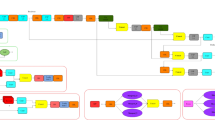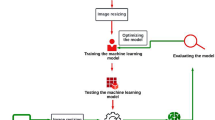Abstract
Deep learning has become a widely practiced approach in research arenas related to civil infrastructures. Monitoring concrete structures is time-consuming, costly, unsafe, and laborious. Instead of manual inspection, the deep learning approach increases more possibility to automate this inspection process helping to mitigate future risk. This study introduces an automatic concrete surface crack detection and classification technique using a deep learning architecture, namely Xception to alleviate the risks due to deteriorating structure conditions. At first, the Xception model was trained and tested on a public dataset consisting of cracked and non-cracked images, and the model has shown superior accuracy in two-class classification. Afterward, the cracked sub-dataset was split into two classes–horizontally cracked and vertically cracked using a traditional computer vision approach to determine the inclination angle of a crack. The proposed deep learning model was trained on the newly formed dataset and performed remarkably in three-class classification as well. This paper demonstrates the proposed model's effectiveness, performance, and findings, providing a reference for concrete surface crack detection and classification for related domains.
Access this chapter
Tax calculation will be finalised at checkout
Purchases are for personal use only
Similar content being viewed by others
References
Madanat, S.M., Karlaftis, M.G., McCarthy, P.S.: probabilistic infrastructure deterioration models with panel data. J. Infrastruct. Syst. 3, 4–9 (1997). https://doi.org/10.1061/(ASCE)1076-0342(1997)3:1(4)
Huang, G., Liu, Z., Van Der Maaten, L., Weinberger, K.Q.: Densely Connected Convolutional Networks. In: 2017 IEEE Conference on Computer Vision and Pattern Recognition (CVPR). pp. 2261–2269. IEEE (2017). https://doi.org/10.1109/CVPR.2017.243
Kim, H., Ahn, E., Cho, S., Shin, M., Sim, S.H.: Comparative analysis of image binarization methods for crack identification in concrete structures. Cem. Concr. Res. 99, 53–61 (2017). https://doi.org/10.1016/J.CEMCONRES.2017.04.018
Song, J., Kim, S., Liu, Z., Quang, N.N., Bien, F.: A real time nondestructive crack detection system for the automotive stamping process. IEEE Trans. Instrum. Meas. 65, 2434–2441 (2016). https://doi.org/10.1109/TIM.2016.2583218
Bas, P.L., Anderson, B.E., Remillieux, M., Pieczonka, L., Ulrich, T.J.: Elasticity Nonlinear Diagnostic method for crack detection and depth estimation. J. Acoust. Soc. Am. 138, 1836 (2015). https://doi.org/10.1121/1.4933844
Liu, Z., Cao, Y., Wang, Y., Wang, W.: Computer vision-based concrete crack detection using U-net fully convolutional networks. Autom. Constr. 104, 129–139 (2019). https://doi.org/10.1016/J.AUTCON.2019.04.005
Mujeeb, A., Dai, W., Erdt, M., Sourin, A.: One class based feature learning approach for defect detection using deep autoencoders. Adv. Eng. Inf. 42, (2019). https://doi.org/10.1016/J.AEI.2019.100933
Lynch, J.P., Farrar, C.R., Michaels, J.E.: Structural health monitoring: technological advances to practical implementations. Proc. IEEE. 104, 1508–1512 (2016). https://doi.org/10.1109/JPROC.2016.2588818
Jahanshahi, M.R., Jazizadeh, F., Masri, S.F., Becerik-Gerber, B.: Unsupervised approach for autonomous pavement-defect detection and quantification using an inexpensive depth sensor. J. Comput. Civ. Eng. 27, 743–754 (2012). https://doi.org/10.1061/(ASCE)CP.1943-5487.0000245
Fujita, Y., Hamamoto, Y.: A robust automatic crack detection method from noisy concrete surfaces. Mach. Vis. Appl. 222(22), 245–254 (2010). https://doi.org/10.1007/S00138-009-0244-5
Zakeri, H., Nejad, F.M., Fahimifar, A.: Image Based Techniques for Crack Detection, Classification and Quantification in Asphalt Pavement: A Review. Arch. Comput. Methods Eng. 2016 244. 24, 935–977 (2016). https://doi.org/10.1007/S11831-016-9194-Z.
Zhang, W., Zhang, Z., Qi, D., Liu, Y.: Automatic crack detection and classification method for subway tunnel safety monitoring. Sensors, 14, 19307–19328 (2014). https://doi.org/10.3390/S141019307
Li, S., Zhao, X.: Image-based concrete crack detection using convolutional neural network and exhaustive search technique. Adv. Civ. Eng. (2019). https://doi.org/10.1155/2019/6520620
Vu Dung, C., Duc Anh, L.: Autonomous concrete crack detection using deep fully convolutional neural network (2018). https://doi.org/10.1016/j.autcon.2018.11.028
Droguett, E.L., Tapia, J., Yanez, C., Boroschek, R.: Semantic segmentation model for crack images from concrete bridges for mobile devices (2020) https://doi.org/10.1177/1748006X20965111
Prasanna, P., Dana, K.J., Gucunski, N., Basily, B.B., La, H.M., Lim, R.S., Parvardeh, H.: Automated crack detection on concrete bridges. IEEE Trans. Autom. Sci. Eng. 13, 591–599 (2016). https://doi.org/10.1109/TASE.2014.2354314
Hsieh, Y.-A., Tsai, Y.J.: Machine learning for crack detection: review and model performance comparison. J. Comput. Civ. Eng. 34, 04020038 (2020). https://doi.org/10.1061/(ASCE)CP.1943-5487.0000918
Pauly, L., Peel, H., Luo, S., Hogg, D., Fuentes, R.: deeper networks for pavement crack detection. In: ISARC 2017 Proceedings of the 34th International Symposium on Automation and Robotics in Construction, pp. 479–485 (2017). https://doi.org/10.22260/ISARC2017/0066
Alipour, M., Harris, D.K.: Increasing the robustness of material-specific deep learning models for crack detection across different materials. Eng. Struct. 206, 110157 (2020). https://doi.org/10.1016/j.engstruct.2019.110157
Chollet, F.: Xception: deep learning with depthwise separable convolutions. In: 2017 IEEE Conference on Computer Vision and Pattern Recognition (CVPR), pp. 1800–1807. IEEE (2017). https://doi.org/10.1109/CVPR.2017.195
Özgenel, Ç.F.: Concrete crack images for classification. Mendeley Data. V2. https://doi.org/10.17632/5y9wdsg2zt.2
Zhang, L., Yang, F., Daniel Zhang, Y., Zhu, Y.J.: Road crack detection using deep convolutional neural network. In: 2016 IEEE International Conference on Image Processing (ICIP), pp. 3708–3712. IEEE (2016). https://doi.org/10.1109/ICIP.2016.7533052
Kannojia, S.P., Jaiswal, G.: Effects of varying resolution on performance of cnn based image classification an experimental study. Int. J. Comput. Sci. Eng. 6, 451–456 (2018). https://doi.org/10.26438/ijcse/v6i9.451456
Flah, M., Suleiman, A.R., Nehdi, M.L.: Classification and quantification of cracks in concrete structures using deep learning image-based techniques. Cem. Concr. Compos. 114, 103781 (2020). https://doi.org/10.1016/j.cemconcomp.2020.103781
Canny, J.: A computational approach to edge detection. IEEE Trans. Pattern Anal. Mach. Intell. PAMI 8, 679–698 (1986). https://doi.org/10.1109/TPAMI.1986.4767851
Vincent, L.: Morphological area openings and closings for grey-scale images. In: Toet, O,Y.-L., Foster, A., Heijmans, D., Meer, P. (eds.) Shape in Picture, pp. 197–208. Springer, Berlin, Heidelberg (1994). https://doi.org/10.1007/978-3-662-03039-4_13
O’Mahony, N., Campbell, S., Carvalho, A., Harapanahalli, S., Hernandez, G.V., Krpalkova, L., Riordan, D., Walsh, J.: Advances in Computer Vision. Springer International Publishing, Cham (2020). https://doi.org/10.1007/978-3-030-17795-9
Guo, Y., Li, Y., Wang, L., Rosing, T.: Depthwise convolution is all you need for learning multiple visual domains. Proc. AAAI Conf. Artif. Intell. 33, 8368–8375 (2019). https://doi.org/10.1609/aaai.v33i01.33018368
Nair, V., Hinton, G.E.: Rectified linear units improve restricted boltzmann machines. In: Fürnkranz, J., Joachims, T. (eds.) Proceedings of the 27th International Conference on Machine Learning (ICML-10), June 21–24, pp. 807–814. Omnipress, Haifa, Israel, (2010)
Goodfellow, I., Bengio, Y., Courville, A.: Deep Learning. MIT Press (2016)
Zeiler, M.D., Ranzato, M., Monga, R., Mao, M., Yang, K., Le, Q.V., Nguyen, P., Senior, A., Vanhoucke, V., Dean, J., Hinton, G.E.: On rectified linear units for speech processing. In: 2013 IEEE International Conference on Acoustics, Speech and Signal Processing, pp. 3517–3521. IEEE (2013). https://doi.org/10.1109/ICASSP.2013.6638312
Srivastava, N., Hinton, G., Krizhevsky, A., Sutskever, I., Salakhutdinov, R.: Dropout: a simple way to prevent neural networks from overfitting. J. Mach. Learn. Res. 15, 1929–1958 (2014)
Ioffe, S., Szegedy, C.: Batch normalization: accelerating deep network training by reducing internal covariate shift. In: 32nd International Conferences Machine Learning ICML, vol. 1, pp. 448–456 (2015)
Bridle, J.S.: Training stochastic model recognition algorithms as networks can lead to maximum mutual information estimation of parameters. In: Proceedings of the 2nd International Conference on Neural Information Processing Systems, pp. 211–217. MIT Press, Cambridge, MA, USA (1989)
Kingma, D.P., Ba, J.: Adam: a method for stochastic optimization. In: 3rd International Conferences Learning Representation ICLR 2015 Conferences Track Proceeding, pp. 1–15 (2014)
Author information
Authors and Affiliations
Corresponding author
Editor information
Editors and Affiliations
Rights and permissions
Copyright information
© 2022 The Author(s), under exclusive license to Springer Nature Singapore Pte Ltd.
About this paper
Cite this paper
Alfaz, N., Hasnat, A., Khan, A.M.R.N., Sayom, N.S. (2022). A Deep Convolutional Neural Network Based Approach to Classify and Detect Crack in Concrete Surface Using Xception. In: Hossain, S., Hossain, M.S., Kaiser, M.S., Majumder, S.P., Ray, K. (eds) Proceedings of International Conference on Fourth Industrial Revolution and Beyond 2021 . Lecture Notes in Networks and Systems, vol 437. Springer, Singapore. https://doi.org/10.1007/978-981-19-2445-3_3
Download citation
DOI: https://doi.org/10.1007/978-981-19-2445-3_3
Published:
Publisher Name: Springer, Singapore
Print ISBN: 978-981-19-2444-6
Online ISBN: 978-981-19-2445-3
eBook Packages: Intelligent Technologies and RoboticsIntelligent Technologies and Robotics (R0)




